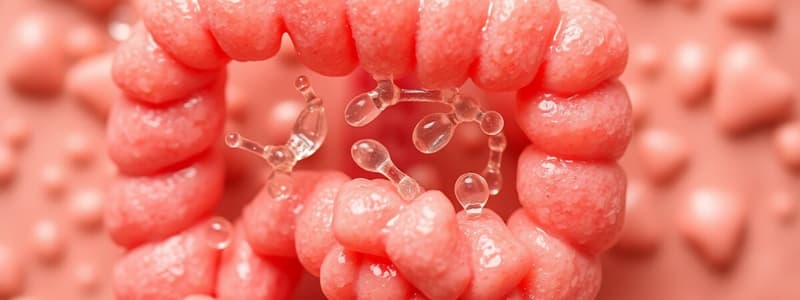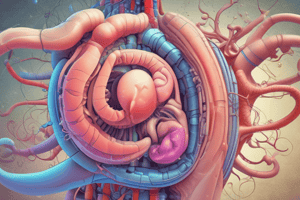Podcast
Questions and Answers
What is a key characteristic of carbohydrate absorption?
What is a key characteristic of carbohydrate absorption?
- It primarily occurs through active transport of oligosaccharides.
- It is a relatively inefficient process.
- It is a very efficient process. (correct)
- It bypasses the portal vein and liver.
Where does the final digestion of oligosaccharides and disaccharides primarily occur?
Where does the final digestion of oligosaccharides and disaccharides primarily occur?
- Within the lumen of the stomach.
- In the liver.
- In the portal vein.
- At the brush border. (correct)
How is fructose absorbed through the luminal membrane?
How is fructose absorbed through the luminal membrane?
- Through simple diffusion.
- Through osmosis.
- Via active transport using the SGLT 1 transporter.
- By facilitated diffusion. (correct)
What is the immediate destination of monosaccharides after absorption in the small intestine?
What is the immediate destination of monosaccharides after absorption in the small intestine?
Based on the diagram, what transporter is located adjacent to the site of final digestion of carbohydrates?
Based on the diagram, what transporter is located adjacent to the site of final digestion of carbohydrates?
Why is lactase activity high at birth in mammals?
Why is lactase activity high at birth in mammals?
What is the primary reason for the decline in lactase activity with age in many mammalian species?
What is the primary reason for the decline in lactase activity with age in many mammalian species?
Which of the following best describes the state of digestive enzyme concentrations at birth in domestic species?
Which of the following best describes the state of digestive enzyme concentrations at birth in domestic species?
What is the consequence of reduced lactase activity in older animals that continue to consume lactose?
What is the consequence of reduced lactase activity in older animals that continue to consume lactose?
How does the delayed development of digestive enzymes (other than lactase) immediately after birth aid in the absorption of maternal antibodies?
How does the delayed development of digestive enzymes (other than lactase) immediately after birth aid in the absorption of maternal antibodies?
Which of the following proteases is active in the stomach?
Which of the following proteases is active in the stomach?
Where does the digestion of di- and tri-peptides into amino acids primarily occur?
Where does the digestion of di- and tri-peptides into amino acids primarily occur?
Which of the transport mechanisms facilitates the absorption of amino acids and peptides in the intestinal brush border?
Which of the transport mechanisms facilitates the absorption of amino acids and peptides in the intestinal brush border?
What is the primary destination of amino acids after absorption from the intestinal brush border?
What is the primary destination of amino acids after absorption from the intestinal brush border?
Which of the following enzymes is NOT a pancreatic protease?
Which of the following enzymes is NOT a pancreatic protease?
Why is the digestion of dietary protein considered a less efficient process in the stomach?
Why is the digestion of dietary protein considered a less efficient process in the stomach?
Which of the following is the only instance when digestion occurs within epithelial cells?
Which of the following is the only instance when digestion occurs within epithelial cells?
Which of the following is a product of protein digestion in the intestinal lumen?
Which of the following is a product of protein digestion in the intestinal lumen?
What primary stimulus triggers the release of cholecystokinin (CCK) during fat digestion?
What primary stimulus triggers the release of cholecystokinin (CCK) during fat digestion?
What is the primary function of bile salts in the process of fat digestion?
What is the primary function of bile salts in the process of fat digestion?
Which structural feature of bile salts allows them to effectively emulsify lipids?
Which structural feature of bile salts allows them to effectively emulsify lipids?
Inside a micelle, what is the arrangement of the hydrophobic and hydrophilic components?
Inside a micelle, what is the arrangement of the hydrophobic and hydrophilic components?
What is the role of lipases in the digestion of triglycerides?
What is the role of lipases in the digestion of triglycerides?
Which of the following is a key difference in fat digestion in horses compared to other mammals with gallbladders?
Which of the following is a key difference in fat digestion in horses compared to other mammals with gallbladders?
What characteristic defines a medium-chain triglyceride (MCT)?
What characteristic defines a medium-chain triglyceride (MCT)?
Why are medium-chain triglycerides (MCTs) sometimes used in pharmaceutical applications?
Why are medium-chain triglycerides (MCTs) sometimes used in pharmaceutical applications?
What happens to bile salt absorption after ileal resection?
What happens to bile salt absorption after ileal resection?
Which of the following statements about fat absorption after ileal resection is true?
Which of the following statements about fat absorption after ileal resection is true?
What is a consequence of reduced fluid and electrolyte absorption after colon resection?
What is a consequence of reduced fluid and electrolyte absorption after colon resection?
How does the intestinal mucosa adapt after injury?
How does the intestinal mucosa adapt after injury?
What dietary change may be recommended for a patient with impaired vitamin B12 absorption due to ileal resection?
What dietary change may be recommended for a patient with impaired vitamin B12 absorption due to ileal resection?
What is the primary purpose of chylomicra entering the liver in a diluted form?
What is the primary purpose of chylomicra entering the liver in a diluted form?
What cellular structure is primarily involved in the packaging of triglycerides with apolipoproteins?
What cellular structure is primarily involved in the packaging of triglycerides with apolipoproteins?
What happens to the surface area of the small intestinal mucosa after damage, such as from viral infections?
What happens to the surface area of the small intestinal mucosa after damage, such as from viral infections?
What factor limits the extent of adaptation in the small intestine after injury?
What factor limits the extent of adaptation in the small intestine after injury?
What is the consequence of intestinal resection on the absorptive surface area?
What is the consequence of intestinal resection on the absorptive surface area?
How do luminal nutrients affect the adaptation process after intestinal injury?
How do luminal nutrients affect the adaptation process after intestinal injury?
Which of the following diets leads to the formation of black fat droplets?
Which of the following diets leads to the formation of black fat droplets?
What are the consequences if the crypt epithelium is damaged?
What are the consequences if the crypt epithelium is damaged?
Flashcards
Carbohydrate Digestion
Carbohydrate Digestion
The breakdown of carbohydrates into simpler sugars for absorption.
Absorption of Fructose
Absorption of Fructose
Fructose is absorbed by facilitated diffusion on the luminal membrane.
Brush Border
Brush Border
The microvilli on the intestinal surface where final digestion occurs.
SGLT 1
SGLT 1
Signup and view all the flashcards
Portal Vein
Portal Vein
Signup and view all the flashcards
Mucosal Brush Border Enzymes
Mucosal Brush Border Enzymes
Signup and view all the flashcards
Lactase
Lactase
Signup and view all the flashcards
Colostrum Absorption
Colostrum Absorption
Signup and view all the flashcards
Lactose Intolerance
Lactose Intolerance
Signup and view all the flashcards
Increased Enzyme Concentration
Increased Enzyme Concentration
Signup and view all the flashcards
Protein Digestion
Protein Digestion
Signup and view all the flashcards
Stomach Role in Digestion
Stomach Role in Digestion
Signup and view all the flashcards
Pancreatic Proteases
Pancreatic Proteases
Signup and view all the flashcards
Absorption of Amino Acids
Absorption of Amino Acids
Signup and view all the flashcards
Oligopeptides
Oligopeptides
Signup and view all the flashcards
Epithelial Cell Digestion
Epithelial Cell Digestion
Signup and view all the flashcards
Na+ and H+-coupled Transport
Na+ and H+-coupled Transport
Signup and view all the flashcards
Portal Vein Function
Portal Vein Function
Signup and view all the flashcards
Chylomicrons
Chylomicrons
Signup and view all the flashcards
Intracellular Space (ICS)
Intracellular Space (ICS)
Signup and view all the flashcards
Exocytosis
Exocytosis
Signup and view all the flashcards
Micelles
Micelles
Signup and view all the flashcards
Intestinal Adaptation
Intestinal Adaptation
Signup and view all the flashcards
Villus Hyperplasia
Villus Hyperplasia
Signup and view all the flashcards
Apolipoproteins
Apolipoproteins
Signup and view all the flashcards
Paracellular Transport
Paracellular Transport
Signup and view all the flashcards
Triglycerides
Triglycerides
Signup and view all the flashcards
Micelle formation
Micelle formation
Signup and view all the flashcards
CCK (Cholecystokinin)
CCK (Cholecystokinin)
Signup and view all the flashcards
Emulsification
Emulsification
Signup and view all the flashcards
Amphipathic bile salts
Amphipathic bile salts
Signup and view all the flashcards
Critical Micelle Concentration (CMC)
Critical Micelle Concentration (CMC)
Signup and view all the flashcards
Lipase digestion
Lipase digestion
Signup and view all the flashcards
Absorption at brush border
Absorption at brush border
Signup and view all the flashcards
Ileal Resection Effects
Ileal Resection Effects
Signup and view all the flashcards
Fat Absorption
Fat Absorption
Signup and view all the flashcards
VFA Absorption
VFA Absorption
Signup and view all the flashcards
Electrolyte Absorption
Electrolyte Absorption
Signup and view all the flashcards
Post-Surgical Adaptation
Post-Surgical Adaptation
Signup and view all the flashcards
Study Notes
Mucosal Digestion and Adaptation
- At birth, most digestive enzymes are low, except lactase, which is present in high concentrations in many species.
- Lactase aids in digesting lactose, the primary sugar in milk.
- Low digestive enzyme levels initially prevent the digestion of colostrum containing immunoglobulins.
- Enzyme concentrations increase with age, except lactase, which often declines.
- Lactase activity decreases or disappears with age in some species early.
- This phenomenon can cause issues like diarrhea in young animals, but can be avoided in many species, most concerning in adults who consume dam's milk (especially from the mother).
- Enzyme activities differ in various species and are measured by units per gram of protein.
- Charts show measurements of several digestive enzyme activities over time. These measure activity of the enzymes in units/g protein, over time in days, measuring results along a logarithmic scale.
Carbohydrate Digestion and Absorption
- Carbohydrate digestion is an efficient process.
- Digestion occurs extracellularly within the intestinal lumen involving various enzymes.
- Carbohydrate breakdown products, such as oligosaccharides, disaccharides, and monosaccharides are absorbed.
- Fructose absorption is facilitated by diffusion mechanisms
- Final digestion of oligosaccharides and disaccharides occurs adjacent to monosaccharide transporters.
Protein Digestion and Absorption
- Protein digestion is a less efficient process than carbohydrate digestion.
- This is due to enzymes having poor access to 3D protein structures.
- Digestion begins in the stomach and continues in the small intestine.
- Final products are amino acids which are actively transported into the bloodstream
Fat Digestion and Absorption
- Main dietary fat is triglycerides.
- Bile salts aid in emulsifying fats (forming micelles), increasing surface area accessible to lipases.
- Lipases hydrolyze ester links in triglycerides.
- These digested products, including fatty acids, and glycerol are absorbed into epithelial cells.
- Micelles increase surface area, aiding access by lipases.
- Products are re-esterified and assembled into chylomicrons which enter lymphatic vessels, rather than the bloodstream,
Adaptation
- Adaptation is enhanced, in cases where there's a limited damage/repair processes to the small intestine's mucosal surface.
- Surface area is adapted in response to damages, including larger villi which are made, and more micorvilli for higher absorption rates.
- Damaged intestinal mucosa can respond with villous hyperplasia (increased villi) to restore absorptive function.
- Protein and carbohydrate digestion is more affected by intestinal resection or injury, compared to reactions to carbohydrate digestion.
Intestinal Resection
- Digestion and absorption of carbohydrates may be less affected by intestinal resection or injury compared to protein digestion/absorption.
- Overall fat absorption may decrease, with resultant fat in fecal matter which is referred to as steatorrhea. Also, B12 is impacted.
- Reduced or impaired water and electrolyte absorption may occur after intestinal damage or resection.
Studying That Suits You
Use AI to generate personalized quizzes and flashcards to suit your learning preferences.





